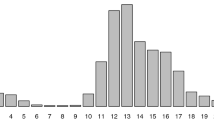Abstract
In the work ozone data from the Liossion monitoring station of the Athens/PERPA network are analysed. Data cover the months May to September for the period 1987–93. Four statistical models, three multiple regression and one ARIMA (0,1,2), for the prediction of the daily maximum 1-hour ozone concentrations are developed. All models together, with a persistence forecast, are evaluated and compared with the 1993's data, not used in the models development. Validation statistics were used to assess the relative accuracy of models. Analysis, concerning the models' ability to forecast real ozone episodes, was also carried out. Two of the three regression models provide the most accurate forecasts. The ARIMA model had the worst performance, even lower than the persistence one. The forecast skill of a bivariate wind speed and persistence based regression model for ozone episode days was found to be quite satisfactory, with a detection rate of 73% and 60% for O3 >180 μg m-3 and O3 >200 μg m-3, respectively.
Similar content being viewed by others
References
Abatzoglou, G., Chaloulakou, A., Assimacopoulos, D. and Lekkas, T.: 1998, 'Prediction of air pollution episodes: Extreme value theory applied in Athens', Environ. Technol. 17, 349–359.
Box, G. E. P. and Jenkins, G.M.: 1976, Time Series Analysis, Forecasting and Control, San Francisco, Holden Day.
Chock, D. P., Terrell, T. R. and Levitt, S. B.: 1975, 'Time series analysis of Riverside, California air quality data', Atmos. Environ. 9, 978–989.
Gusten, H., Heinrich, G., Cvitas, T., Klasing, L., Ruscic, B., Lalas, P. D. and Petrakis, M.: 1988, 'Photochemical formation and transport of ozone in Athens, Greece', Atmos. Environ. 22, 1855–1861.
Lalas, D. P., Karras, G., Pissimanis, K., Notaridou, V. and Kassomenos, P.: 1985, Air Pollution in the Athens Area. Study of Conditions and Mechanisms, Ministry of Physical Planning, Housing and the Environment (PERPA), EEC, DG XI (Final Report).
Lorenzini, G., Nali, G. and Panicucci, A.: 1994, 'Surface ozone in Pisa (Italy): A six-year study', Atmos. Environ. 28, 3155–3164.
Mertz, P. H., Painter, L. G. and Ryason, R. P.: 1972, 'Aerometric data analysis. Time series analysis and forecast and an atmospheric smog diagram', Atmos. Environ. 6, 319–342.
McCollister, G. and Wilson, K.: 1975, 'Linear stochastic models for forecasting daily maxima and hourly concentrations of air pollutants', Atmos. Environ. 9, 417–423.
Pankratz, A.: 1983, Forecasting with Univariative Box-Jenkins Models: Concepts and Cases, New York, John Wiley and Sons.
Prior, E. J., Schiess, J. R. and McDougal, D. S.: 1981, 'Approach to forecasting daily maximum ozone levels in St. Louis', Env. Sci. Technol. 15, 430–436.
Rao, S. T. and Visalli, J. R.: 1981, 'On the comparative assessment of the performance of air-quality models', J. Air Pollut. Control Assoc. 31, 851–860.
Remsberg, E. E. and Woodbury, G. E.: 1983, 'Stability of the surface layer and its relation to the dispersion of primary pollutants in St. Louis', J. Clim. Appl. Met. 22, 244–255.
Revlett, G.: 1978, 'Ozone forecasting using Empirical Modeling', J. Air Pollut. Control Assoc. 28, 338–343.
Robeson, S. and Steyn, D.: 1989, 'Evaluation and comparison of statistical forecast models for daily maximum ozone concentrations', Atmos. Environ. 24B, 303–312.
Ryan, W. F.: 1995, 'Forecasting severe ozone episodes in the Baltimore Metropolitan Area', Atmos. Environ. 29(17), 2387–2398.
Simpson, R. and Layton, A.: 1983, 'Forecasting peak ozone levels', Atmos. Environ. 17, 1649–1654.
Surman, P. G., Bodero, J. and Simpson, R. W.: 1987, 'The prediction of the numbers of violations and the frequency of air pollution episodes using extreme value theory', Atmos. Environ. 21, 1843–1848.
Tiao, G. C., Phadke, M. S. and Box, G. E. P.: 1976, 'Some empirical models for the Los Angeles photochemical smog data', J. Air Pollut. Control Assoc. 26, 485–490.
Willmott, C. J., Acckleson, S. G., Davis, R. E. Feddema, J. J., Klink, K. M., Legates, D. R., O'Donnell, J. and Rowe, C. M.: 1985, 'Statistics for the evaluation and comparison of models', J. Geophys. Res. 90, 8995–9005.
Wolff, G. and Lioy, P.: 1978, 'An empirical model for forecasting Maximum daily Ozone levels in the NE U.S.', J. Air Pollut. Control Assoc. 28, pp1034–1038.
Rights and permissions
About this article
Cite this article
Chaloulakou, A., Assimacopoulos*, D. & Lekkas, T. Forecasting Daily Maximum Ozone Concentrations in the Athens Basin. Environ Monit Assess 56, 97–112 (1999). https://doi.org/10.1023/A:1005943201063
Issue Date:
DOI: https://doi.org/10.1023/A:1005943201063




